Public Policy and Health: Analysis of Policy Cycle and Health Issues
VerifiedAdded on 2021/04/17
|9
|2391
|326
Report
AI Summary
This report examines the interplay between public policy and health, offering a comprehensive analysis of key concepts and issues. It begins by exploring the policy cycle as a crucial tool for developing effective health policies, followed by a differentiation between health policy and government policy statements. The report then contrasts the 'new public health' approach with the 'old public health' approach, highlighting the evolution of health considerations. A significant portion of the report is dedicated to identifying key sociological issues that determine a person's state of health, emphasizing factors such as social inclusion, relative poverty, and sanitary conditions. Finally, the report outlines essential policy considerations for a national obesity health campaign, including awareness initiatives, nutritional guidelines, and taxation strategies, providing a holistic perspective on addressing this critical public health challenge. The report is designed to help students understand the complexities of public health policy and potential solutions.
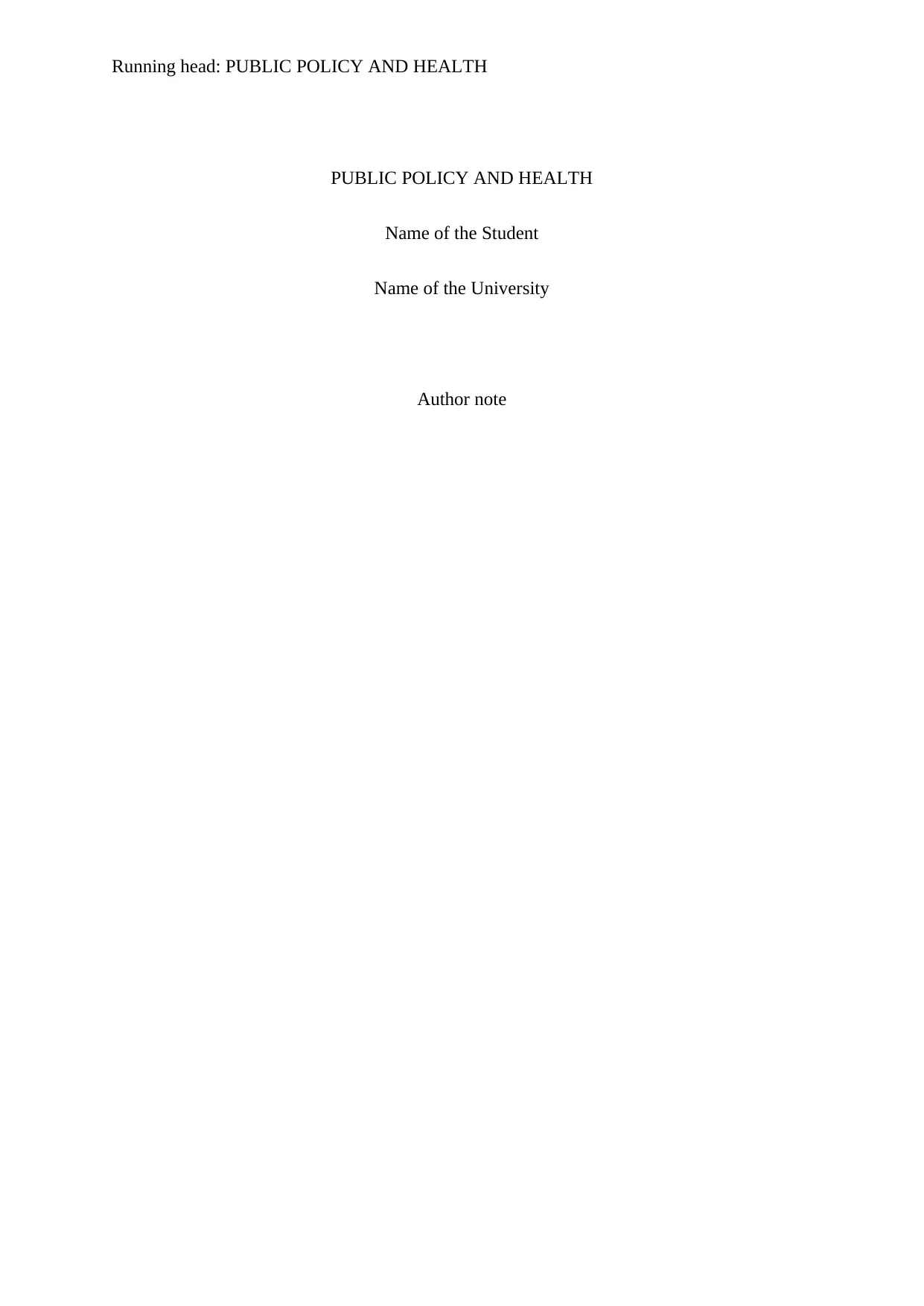
Running head: PUBLIC POLICY AND HEALTH
PUBLIC POLICY AND HEALTH
Name of the Student
Name of the University
Author note
PUBLIC POLICY AND HEALTH
Name of the Student
Name of the University
Author note
Paraphrase This Document
Need a fresh take? Get an instant paraphrase of this document with our AI Paraphraser
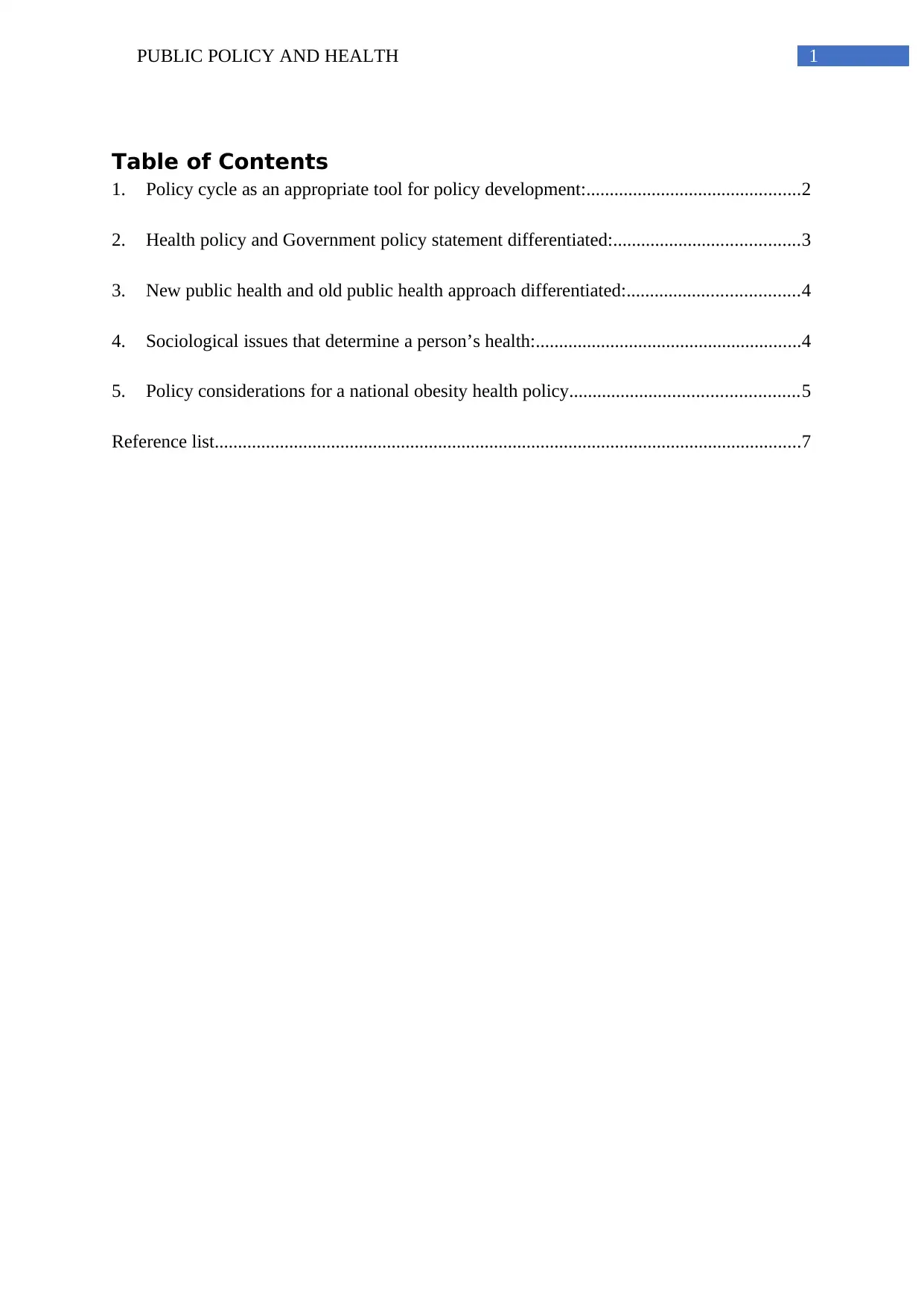
1PUBLIC POLICY AND HEALTH
Table of Contents
1. Policy cycle as an appropriate tool for policy development:..............................................2
2. Health policy and Government policy statement differentiated:........................................3
3. New public health and old public health approach differentiated:.....................................4
4. Sociological issues that determine a person’s health:.........................................................4
5. Policy considerations for a national obesity health policy.................................................5
Reference list..............................................................................................................................7
Table of Contents
1. Policy cycle as an appropriate tool for policy development:..............................................2
2. Health policy and Government policy statement differentiated:........................................3
3. New public health and old public health approach differentiated:.....................................4
4. Sociological issues that determine a person’s health:.........................................................4
5. Policy considerations for a national obesity health policy.................................................5
Reference list..............................................................................................................................7
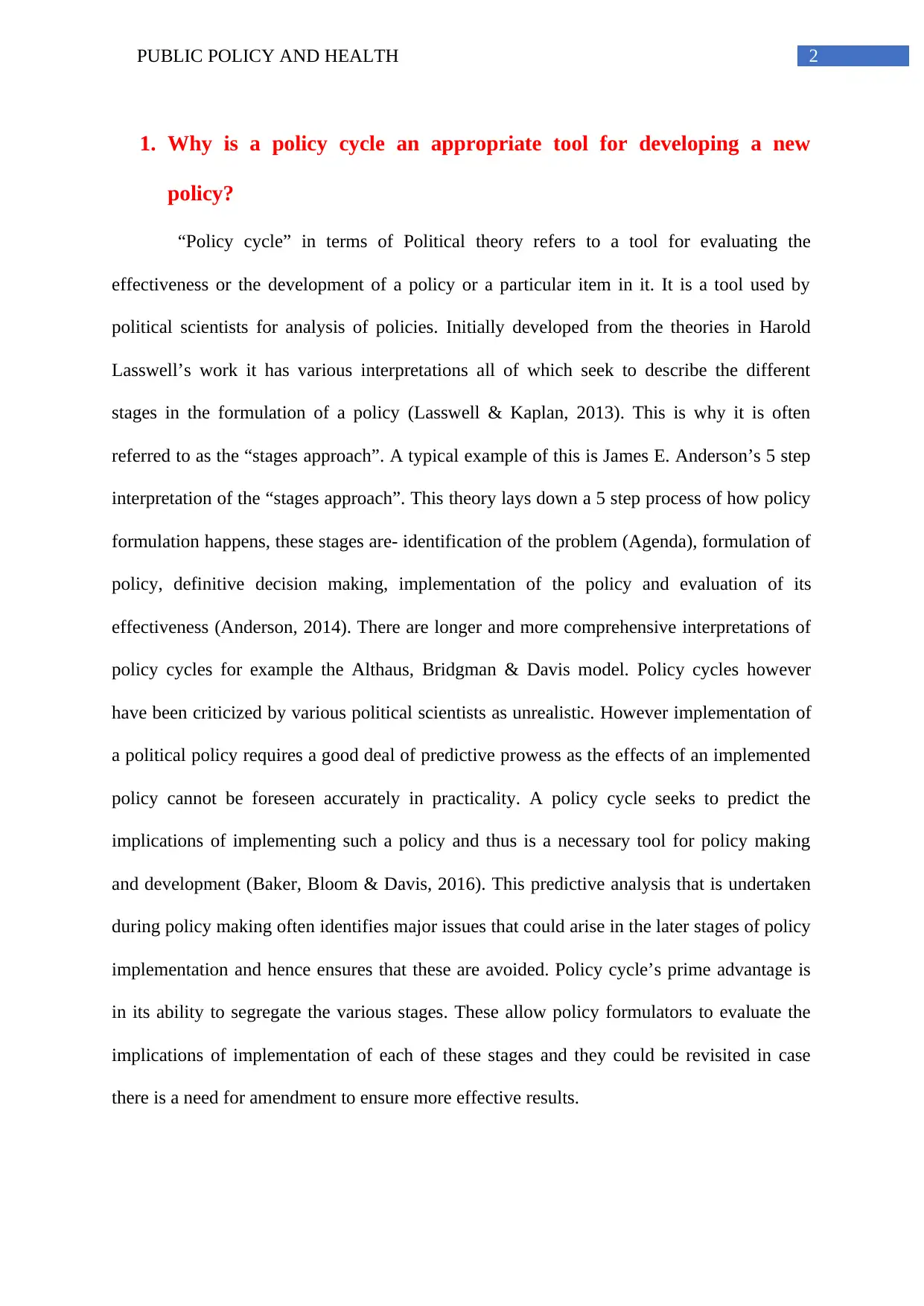
2PUBLIC POLICY AND HEALTH
1. Why is a policy cycle an appropriate tool for developing a new
policy?
“Policy cycle” in terms of Political theory refers to a tool for evaluating the
effectiveness or the development of a policy or a particular item in it. It is a tool used by
political scientists for analysis of policies. Initially developed from the theories in Harold
Lasswell’s work it has various interpretations all of which seek to describe the different
stages in the formulation of a policy (Lasswell & Kaplan, 2013). This is why it is often
referred to as the “stages approach”. A typical example of this is James E. Anderson’s 5 step
interpretation of the “stages approach”. This theory lays down a 5 step process of how policy
formulation happens, these stages are- identification of the problem (Agenda), formulation of
policy, definitive decision making, implementation of the policy and evaluation of its
effectiveness (Anderson, 2014). There are longer and more comprehensive interpretations of
policy cycles for example the Althaus, Bridgman & Davis model. Policy cycles however
have been criticized by various political scientists as unrealistic. However implementation of
a political policy requires a good deal of predictive prowess as the effects of an implemented
policy cannot be foreseen accurately in practicality. A policy cycle seeks to predict the
implications of implementing such a policy and thus is a necessary tool for policy making
and development (Baker, Bloom & Davis, 2016). This predictive analysis that is undertaken
during policy making often identifies major issues that could arise in the later stages of policy
implementation and hence ensures that these are avoided. Policy cycle’s prime advantage is
in its ability to segregate the various stages. These allow policy formulators to evaluate the
implications of implementation of each of these stages and they could be revisited in case
there is a need for amendment to ensure more effective results.
1. Why is a policy cycle an appropriate tool for developing a new
policy?
“Policy cycle” in terms of Political theory refers to a tool for evaluating the
effectiveness or the development of a policy or a particular item in it. It is a tool used by
political scientists for analysis of policies. Initially developed from the theories in Harold
Lasswell’s work it has various interpretations all of which seek to describe the different
stages in the formulation of a policy (Lasswell & Kaplan, 2013). This is why it is often
referred to as the “stages approach”. A typical example of this is James E. Anderson’s 5 step
interpretation of the “stages approach”. This theory lays down a 5 step process of how policy
formulation happens, these stages are- identification of the problem (Agenda), formulation of
policy, definitive decision making, implementation of the policy and evaluation of its
effectiveness (Anderson, 2014). There are longer and more comprehensive interpretations of
policy cycles for example the Althaus, Bridgman & Davis model. Policy cycles however
have been criticized by various political scientists as unrealistic. However implementation of
a political policy requires a good deal of predictive prowess as the effects of an implemented
policy cannot be foreseen accurately in practicality. A policy cycle seeks to predict the
implications of implementing such a policy and thus is a necessary tool for policy making
and development (Baker, Bloom & Davis, 2016). This predictive analysis that is undertaken
during policy making often identifies major issues that could arise in the later stages of policy
implementation and hence ensures that these are avoided. Policy cycle’s prime advantage is
in its ability to segregate the various stages. These allow policy formulators to evaluate the
implications of implementation of each of these stages and they could be revisited in case
there is a need for amendment to ensure more effective results.
⊘ This is a preview!⊘
Do you want full access?
Subscribe today to unlock all pages.

Trusted by 1+ million students worldwide
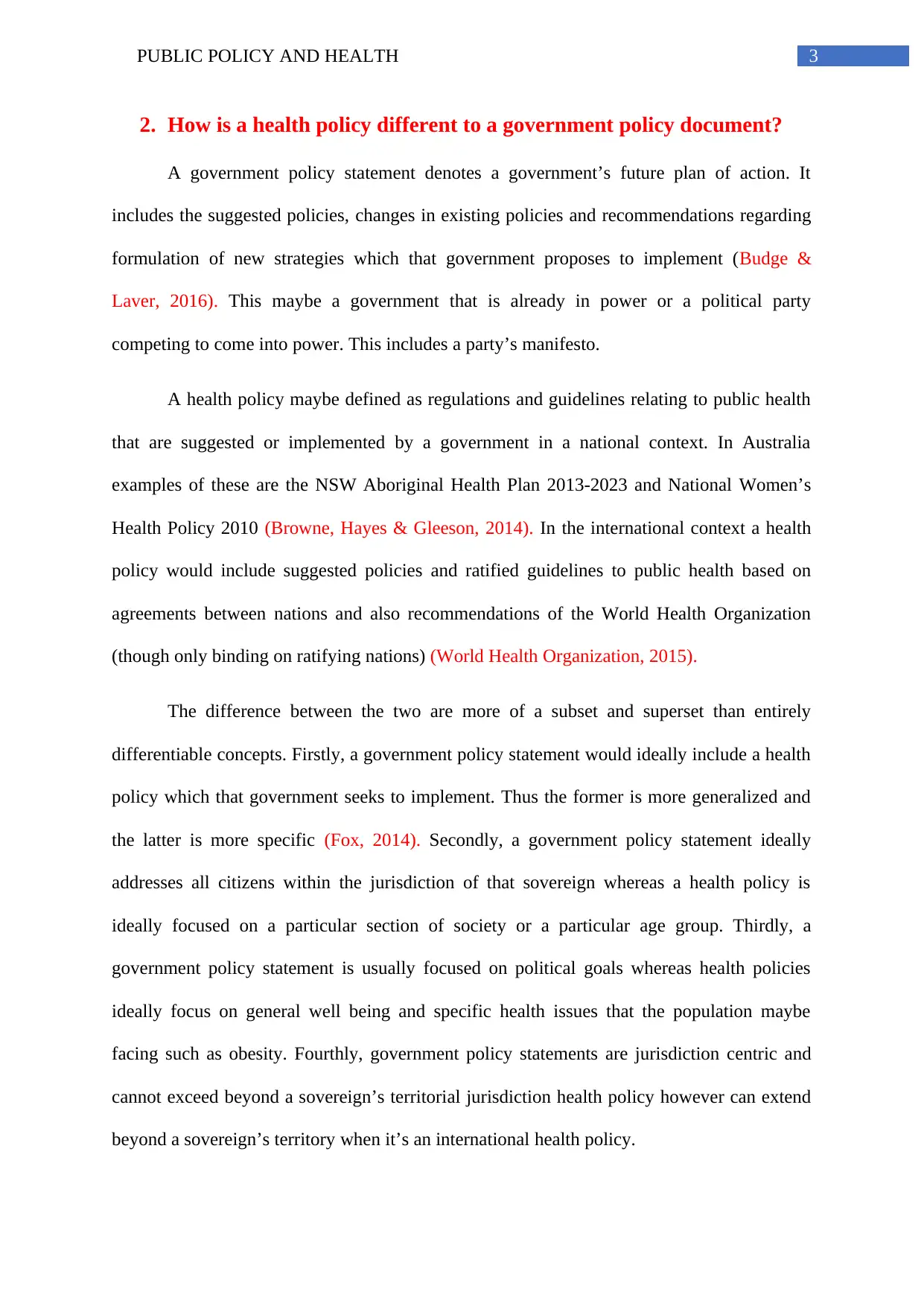
3PUBLIC POLICY AND HEALTH
2. How is a health policy different to a government policy document?
A government policy statement denotes a government’s future plan of action. It
includes the suggested policies, changes in existing policies and recommendations regarding
formulation of new strategies which that government proposes to implement (Budge &
Laver, 2016). This maybe a government that is already in power or a political party
competing to come into power. This includes a party’s manifesto.
A health policy maybe defined as regulations and guidelines relating to public health
that are suggested or implemented by a government in a national context. In Australia
examples of these are the NSW Aboriginal Health Plan 2013-2023 and National Women’s
Health Policy 2010 (Browne, Hayes & Gleeson, 2014). In the international context a health
policy would include suggested policies and ratified guidelines to public health based on
agreements between nations and also recommendations of the World Health Organization
(though only binding on ratifying nations) (World Health Organization, 2015).
The difference between the two are more of a subset and superset than entirely
differentiable concepts. Firstly, a government policy statement would ideally include a health
policy which that government seeks to implement. Thus the former is more generalized and
the latter is more specific (Fox, 2014). Secondly, a government policy statement ideally
addresses all citizens within the jurisdiction of that sovereign whereas a health policy is
ideally focused on a particular section of society or a particular age group. Thirdly, a
government policy statement is usually focused on political goals whereas health policies
ideally focus on general well being and specific health issues that the population maybe
facing such as obesity. Fourthly, government policy statements are jurisdiction centric and
cannot exceed beyond a sovereign’s territorial jurisdiction health policy however can extend
beyond a sovereign’s territory when it’s an international health policy.
2. How is a health policy different to a government policy document?
A government policy statement denotes a government’s future plan of action. It
includes the suggested policies, changes in existing policies and recommendations regarding
formulation of new strategies which that government proposes to implement (Budge &
Laver, 2016). This maybe a government that is already in power or a political party
competing to come into power. This includes a party’s manifesto.
A health policy maybe defined as regulations and guidelines relating to public health
that are suggested or implemented by a government in a national context. In Australia
examples of these are the NSW Aboriginal Health Plan 2013-2023 and National Women’s
Health Policy 2010 (Browne, Hayes & Gleeson, 2014). In the international context a health
policy would include suggested policies and ratified guidelines to public health based on
agreements between nations and also recommendations of the World Health Organization
(though only binding on ratifying nations) (World Health Organization, 2015).
The difference between the two are more of a subset and superset than entirely
differentiable concepts. Firstly, a government policy statement would ideally include a health
policy which that government seeks to implement. Thus the former is more generalized and
the latter is more specific (Fox, 2014). Secondly, a government policy statement ideally
addresses all citizens within the jurisdiction of that sovereign whereas a health policy is
ideally focused on a particular section of society or a particular age group. Thirdly, a
government policy statement is usually focused on political goals whereas health policies
ideally focus on general well being and specific health issues that the population maybe
facing such as obesity. Fourthly, government policy statements are jurisdiction centric and
cannot exceed beyond a sovereign’s territorial jurisdiction health policy however can extend
beyond a sovereign’s territory when it’s an international health policy.
Paraphrase This Document
Need a fresh take? Get an instant paraphrase of this document with our AI Paraphraser
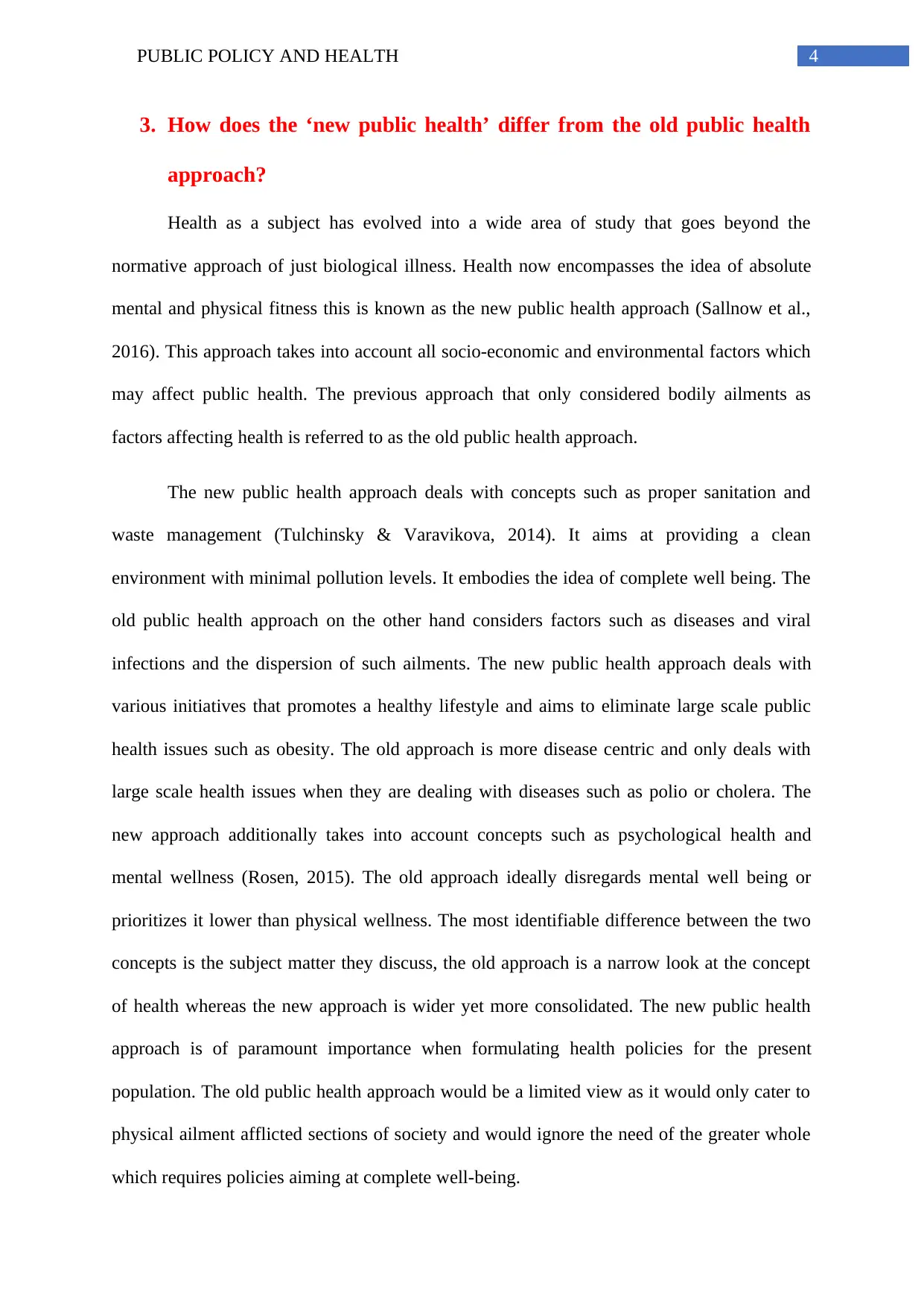
4PUBLIC POLICY AND HEALTH
3. How does the ‘new public health’ differ from the old public health
approach?
Health as a subject has evolved into a wide area of study that goes beyond the
normative approach of just biological illness. Health now encompasses the idea of absolute
mental and physical fitness this is known as the new public health approach (Sallnow et al.,
2016). This approach takes into account all socio-economic and environmental factors which
may affect public health. The previous approach that only considered bodily ailments as
factors affecting health is referred to as the old public health approach.
The new public health approach deals with concepts such as proper sanitation and
waste management (Tulchinsky & Varavikova, 2014). It aims at providing a clean
environment with minimal pollution levels. It embodies the idea of complete well being. The
old public health approach on the other hand considers factors such as diseases and viral
infections and the dispersion of such ailments. The new public health approach deals with
various initiatives that promotes a healthy lifestyle and aims to eliminate large scale public
health issues such as obesity. The old approach is more disease centric and only deals with
large scale health issues when they are dealing with diseases such as polio or cholera. The
new approach additionally takes into account concepts such as psychological health and
mental wellness (Rosen, 2015). The old approach ideally disregards mental well being or
prioritizes it lower than physical wellness. The most identifiable difference between the two
concepts is the subject matter they discuss, the old approach is a narrow look at the concept
of health whereas the new approach is wider yet more consolidated. The new public health
approach is of paramount importance when formulating health policies for the present
population. The old public health approach would be a limited view as it would only cater to
physical ailment afflicted sections of society and would ignore the need of the greater whole
which requires policies aiming at complete well-being.
3. How does the ‘new public health’ differ from the old public health
approach?
Health as a subject has evolved into a wide area of study that goes beyond the
normative approach of just biological illness. Health now encompasses the idea of absolute
mental and physical fitness this is known as the new public health approach (Sallnow et al.,
2016). This approach takes into account all socio-economic and environmental factors which
may affect public health. The previous approach that only considered bodily ailments as
factors affecting health is referred to as the old public health approach.
The new public health approach deals with concepts such as proper sanitation and
waste management (Tulchinsky & Varavikova, 2014). It aims at providing a clean
environment with minimal pollution levels. It embodies the idea of complete well being. The
old public health approach on the other hand considers factors such as diseases and viral
infections and the dispersion of such ailments. The new public health approach deals with
various initiatives that promotes a healthy lifestyle and aims to eliminate large scale public
health issues such as obesity. The old approach is more disease centric and only deals with
large scale health issues when they are dealing with diseases such as polio or cholera. The
new approach additionally takes into account concepts such as psychological health and
mental wellness (Rosen, 2015). The old approach ideally disregards mental well being or
prioritizes it lower than physical wellness. The most identifiable difference between the two
concepts is the subject matter they discuss, the old approach is a narrow look at the concept
of health whereas the new approach is wider yet more consolidated. The new public health
approach is of paramount importance when formulating health policies for the present
population. The old public health approach would be a limited view as it would only cater to
physical ailment afflicted sections of society and would ignore the need of the greater whole
which requires policies aiming at complete well-being.
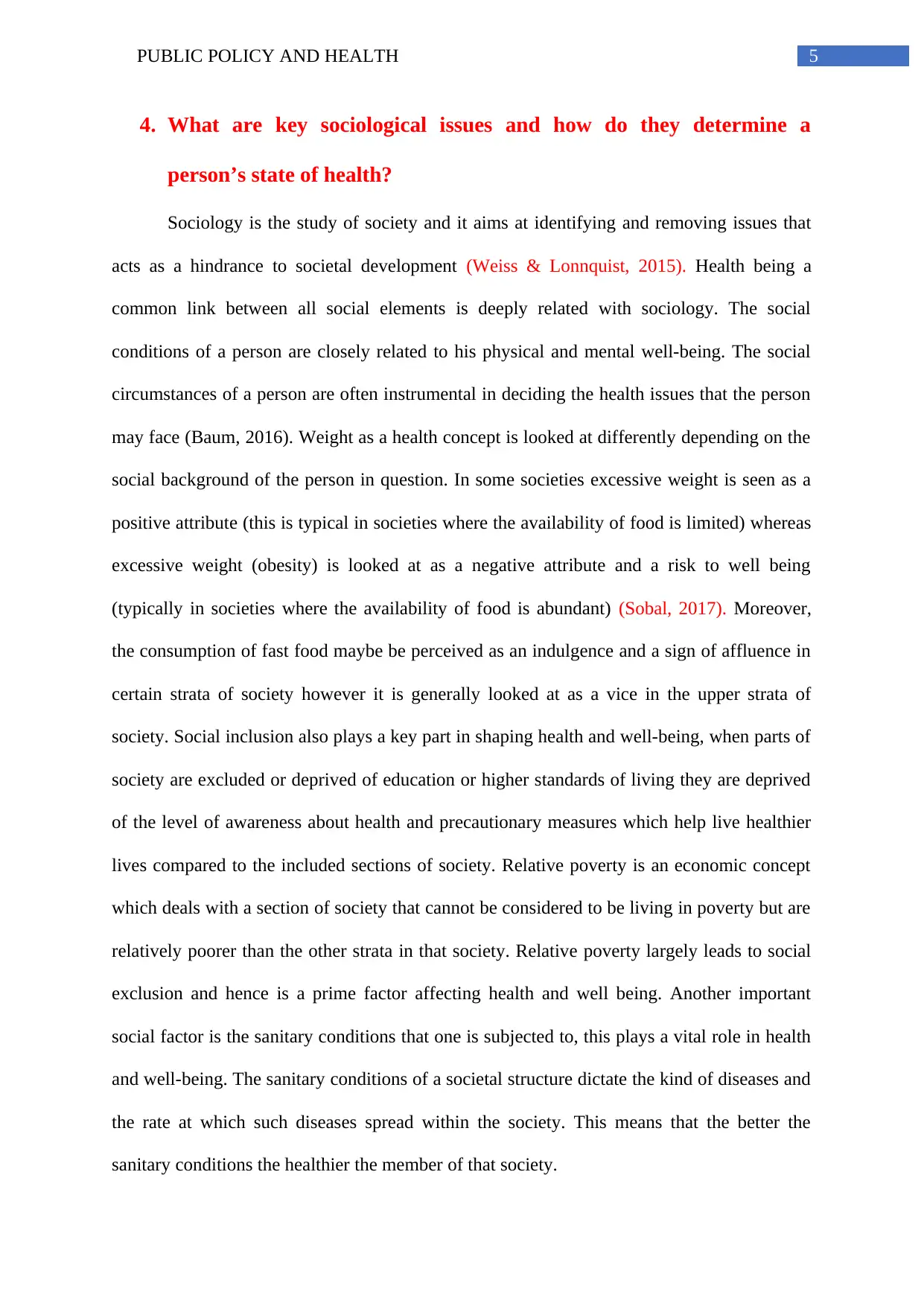
5PUBLIC POLICY AND HEALTH
4. What are key sociological issues and how do they determine a
person’s state of health?
Sociology is the study of society and it aims at identifying and removing issues that
acts as a hindrance to societal development (Weiss & Lonnquist, 2015). Health being a
common link between all social elements is deeply related with sociology. The social
conditions of a person are closely related to his physical and mental well-being. The social
circumstances of a person are often instrumental in deciding the health issues that the person
may face (Baum, 2016). Weight as a health concept is looked at differently depending on the
social background of the person in question. In some societies excessive weight is seen as a
positive attribute (this is typical in societies where the availability of food is limited) whereas
excessive weight (obesity) is looked at as a negative attribute and a risk to well being
(typically in societies where the availability of food is abundant) (Sobal, 2017). Moreover,
the consumption of fast food maybe be perceived as an indulgence and a sign of affluence in
certain strata of society however it is generally looked at as a vice in the upper strata of
society. Social inclusion also plays a key part in shaping health and well-being, when parts of
society are excluded or deprived of education or higher standards of living they are deprived
of the level of awareness about health and precautionary measures which help live healthier
lives compared to the included sections of society. Relative poverty is an economic concept
which deals with a section of society that cannot be considered to be living in poverty but are
relatively poorer than the other strata in that society. Relative poverty largely leads to social
exclusion and hence is a prime factor affecting health and well being. Another important
social factor is the sanitary conditions that one is subjected to, this plays a vital role in health
and well-being. The sanitary conditions of a societal structure dictate the kind of diseases and
the rate at which such diseases spread within the society. This means that the better the
sanitary conditions the healthier the member of that society.
4. What are key sociological issues and how do they determine a
person’s state of health?
Sociology is the study of society and it aims at identifying and removing issues that
acts as a hindrance to societal development (Weiss & Lonnquist, 2015). Health being a
common link between all social elements is deeply related with sociology. The social
conditions of a person are closely related to his physical and mental well-being. The social
circumstances of a person are often instrumental in deciding the health issues that the person
may face (Baum, 2016). Weight as a health concept is looked at differently depending on the
social background of the person in question. In some societies excessive weight is seen as a
positive attribute (this is typical in societies where the availability of food is limited) whereas
excessive weight (obesity) is looked at as a negative attribute and a risk to well being
(typically in societies where the availability of food is abundant) (Sobal, 2017). Moreover,
the consumption of fast food maybe be perceived as an indulgence and a sign of affluence in
certain strata of society however it is generally looked at as a vice in the upper strata of
society. Social inclusion also plays a key part in shaping health and well-being, when parts of
society are excluded or deprived of education or higher standards of living they are deprived
of the level of awareness about health and precautionary measures which help live healthier
lives compared to the included sections of society. Relative poverty is an economic concept
which deals with a section of society that cannot be considered to be living in poverty but are
relatively poorer than the other strata in that society. Relative poverty largely leads to social
exclusion and hence is a prime factor affecting health and well being. Another important
social factor is the sanitary conditions that one is subjected to, this plays a vital role in health
and well-being. The sanitary conditions of a societal structure dictate the kind of diseases and
the rate at which such diseases spread within the society. This means that the better the
sanitary conditions the healthier the member of that society.
⊘ This is a preview!⊘
Do you want full access?
Subscribe today to unlock all pages.

Trusted by 1+ million students worldwide
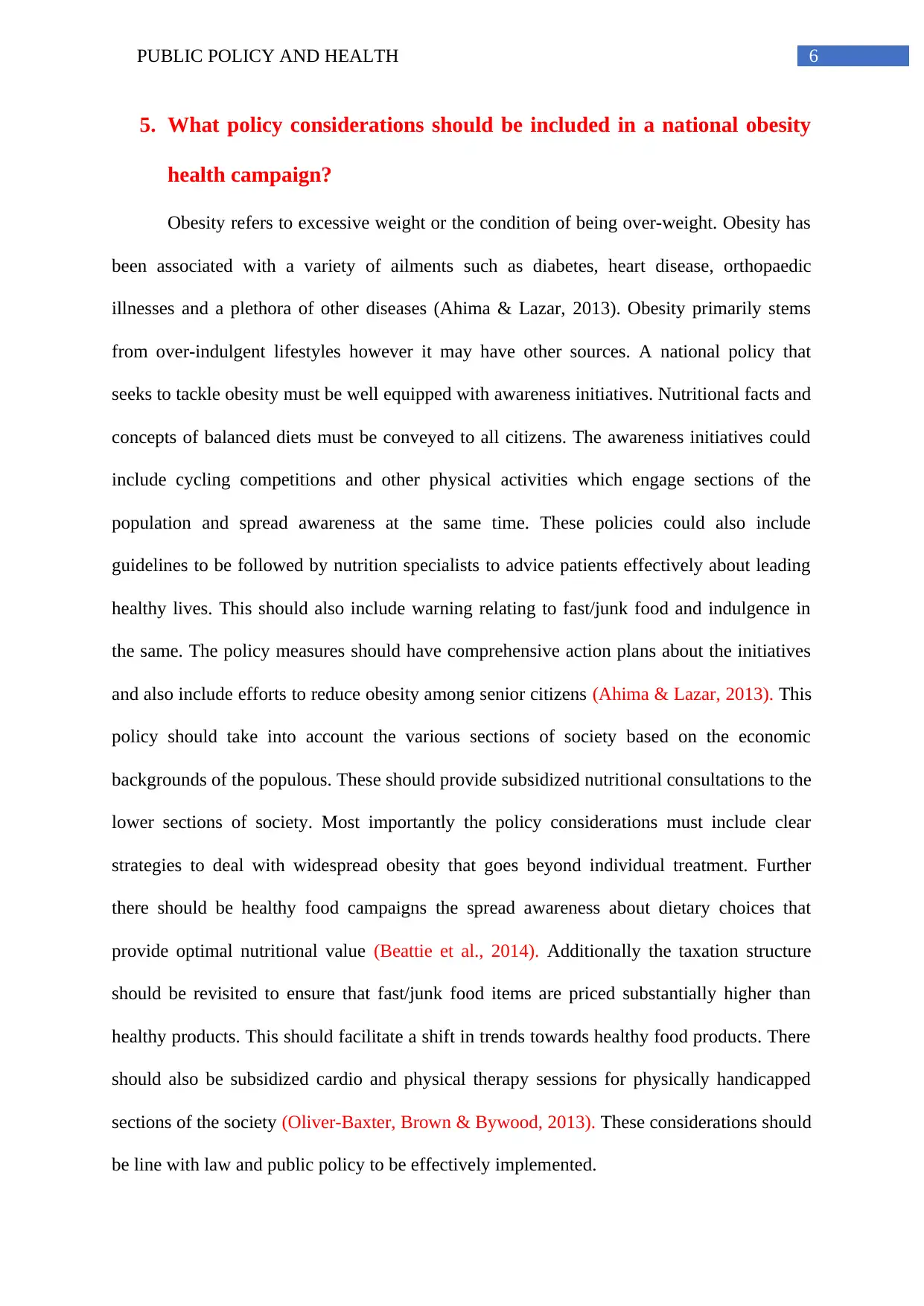
6PUBLIC POLICY AND HEALTH
5. What policy considerations should be included in a national obesity
health campaign?
Obesity refers to excessive weight or the condition of being over-weight. Obesity has
been associated with a variety of ailments such as diabetes, heart disease, orthopaedic
illnesses and a plethora of other diseases (Ahima & Lazar, 2013). Obesity primarily stems
from over-indulgent lifestyles however it may have other sources. A national policy that
seeks to tackle obesity must be well equipped with awareness initiatives. Nutritional facts and
concepts of balanced diets must be conveyed to all citizens. The awareness initiatives could
include cycling competitions and other physical activities which engage sections of the
population and spread awareness at the same time. These policies could also include
guidelines to be followed by nutrition specialists to advice patients effectively about leading
healthy lives. This should also include warning relating to fast/junk food and indulgence in
the same. The policy measures should have comprehensive action plans about the initiatives
and also include efforts to reduce obesity among senior citizens (Ahima & Lazar, 2013). This
policy should take into account the various sections of society based on the economic
backgrounds of the populous. These should provide subsidized nutritional consultations to the
lower sections of society. Most importantly the policy considerations must include clear
strategies to deal with widespread obesity that goes beyond individual treatment. Further
there should be healthy food campaigns the spread awareness about dietary choices that
provide optimal nutritional value (Beattie et al., 2014). Additionally the taxation structure
should be revisited to ensure that fast/junk food items are priced substantially higher than
healthy products. This should facilitate a shift in trends towards healthy food products. There
should also be subsidized cardio and physical therapy sessions for physically handicapped
sections of the society (Oliver-Baxter, Brown & Bywood, 2013). These considerations should
be line with law and public policy to be effectively implemented.
5. What policy considerations should be included in a national obesity
health campaign?
Obesity refers to excessive weight or the condition of being over-weight. Obesity has
been associated with a variety of ailments such as diabetes, heart disease, orthopaedic
illnesses and a plethora of other diseases (Ahima & Lazar, 2013). Obesity primarily stems
from over-indulgent lifestyles however it may have other sources. A national policy that
seeks to tackle obesity must be well equipped with awareness initiatives. Nutritional facts and
concepts of balanced diets must be conveyed to all citizens. The awareness initiatives could
include cycling competitions and other physical activities which engage sections of the
population and spread awareness at the same time. These policies could also include
guidelines to be followed by nutrition specialists to advice patients effectively about leading
healthy lives. This should also include warning relating to fast/junk food and indulgence in
the same. The policy measures should have comprehensive action plans about the initiatives
and also include efforts to reduce obesity among senior citizens (Ahima & Lazar, 2013). This
policy should take into account the various sections of society based on the economic
backgrounds of the populous. These should provide subsidized nutritional consultations to the
lower sections of society. Most importantly the policy considerations must include clear
strategies to deal with widespread obesity that goes beyond individual treatment. Further
there should be healthy food campaigns the spread awareness about dietary choices that
provide optimal nutritional value (Beattie et al., 2014). Additionally the taxation structure
should be revisited to ensure that fast/junk food items are priced substantially higher than
healthy products. This should facilitate a shift in trends towards healthy food products. There
should also be subsidized cardio and physical therapy sessions for physically handicapped
sections of the society (Oliver-Baxter, Brown & Bywood, 2013). These considerations should
be line with law and public policy to be effectively implemented.
Paraphrase This Document
Need a fresh take? Get an instant paraphrase of this document with our AI Paraphraser
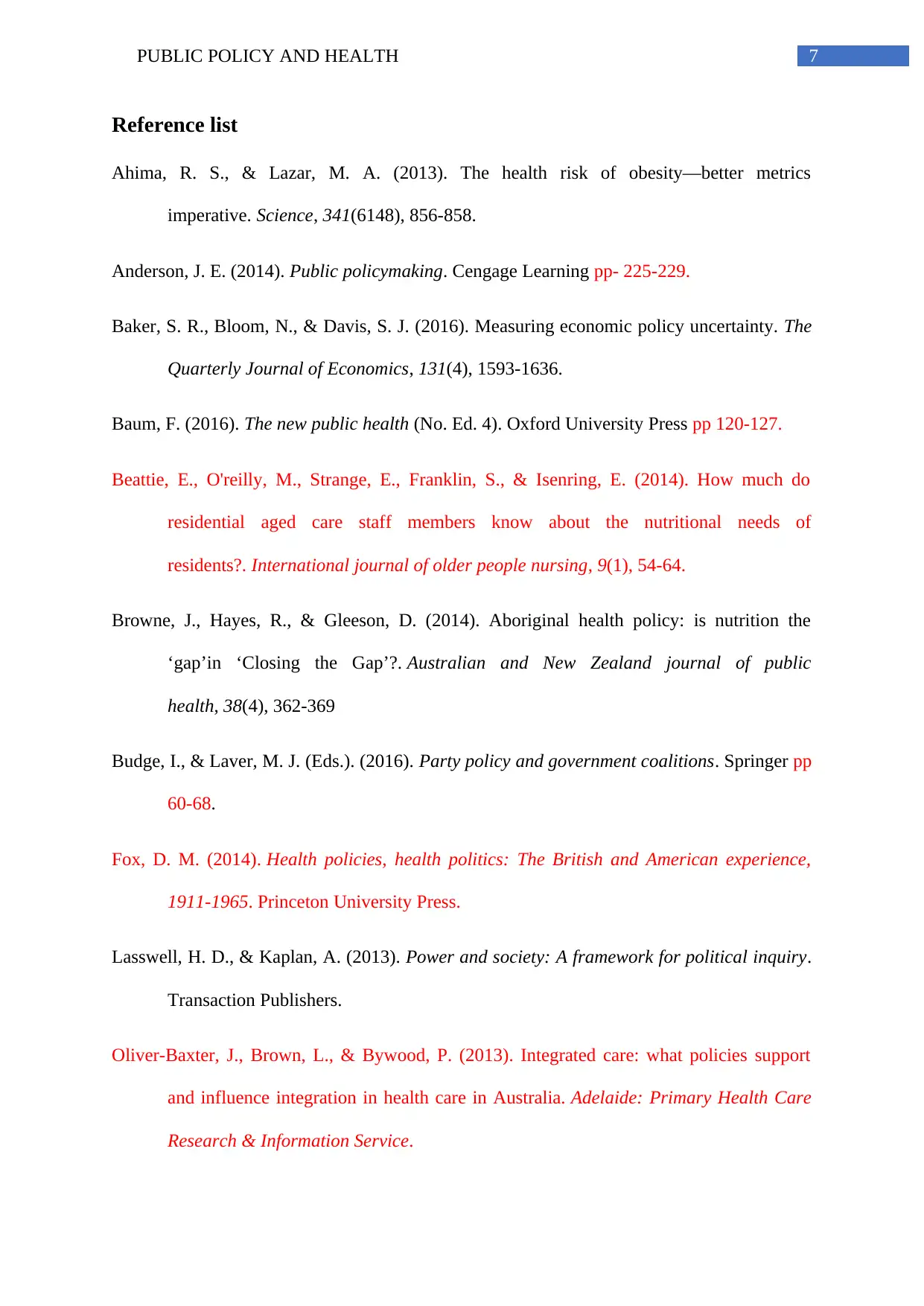
7PUBLIC POLICY AND HEALTH
Reference list
Ahima, R. S., & Lazar, M. A. (2013). The health risk of obesity—better metrics
imperative. Science, 341(6148), 856-858.
Anderson, J. E. (2014). Public policymaking. Cengage Learning pp- 225-229.
Baker, S. R., Bloom, N., & Davis, S. J. (2016). Measuring economic policy uncertainty. The
Quarterly Journal of Economics, 131(4), 1593-1636.
Baum, F. (2016). The new public health (No. Ed. 4). Oxford University Press pp 120-127.
Beattie, E., O'reilly, M., Strange, E., Franklin, S., & Isenring, E. (2014). How much do
residential aged care staff members know about the nutritional needs of
residents?. International journal of older people nursing, 9(1), 54-64.
Browne, J., Hayes, R., & Gleeson, D. (2014). Aboriginal health policy: is nutrition the
‘gap’in ‘Closing the Gap’?. Australian and New Zealand journal of public
health, 38(4), 362-369
Budge, I., & Laver, M. J. (Eds.). (2016). Party policy and government coalitions. Springer pp
60-68.
Fox, D. M. (2014). Health policies, health politics: The British and American experience,
1911-1965. Princeton University Press.
Lasswell, H. D., & Kaplan, A. (2013). Power and society: A framework for political inquiry.
Transaction Publishers.
Oliver-Baxter, J., Brown, L., & Bywood, P. (2013). Integrated care: what policies support
and influence integration in health care in Australia. Adelaide: Primary Health Care
Research & Information Service.
Reference list
Ahima, R. S., & Lazar, M. A. (2013). The health risk of obesity—better metrics
imperative. Science, 341(6148), 856-858.
Anderson, J. E. (2014). Public policymaking. Cengage Learning pp- 225-229.
Baker, S. R., Bloom, N., & Davis, S. J. (2016). Measuring economic policy uncertainty. The
Quarterly Journal of Economics, 131(4), 1593-1636.
Baum, F. (2016). The new public health (No. Ed. 4). Oxford University Press pp 120-127.
Beattie, E., O'reilly, M., Strange, E., Franklin, S., & Isenring, E. (2014). How much do
residential aged care staff members know about the nutritional needs of
residents?. International journal of older people nursing, 9(1), 54-64.
Browne, J., Hayes, R., & Gleeson, D. (2014). Aboriginal health policy: is nutrition the
‘gap’in ‘Closing the Gap’?. Australian and New Zealand journal of public
health, 38(4), 362-369
Budge, I., & Laver, M. J. (Eds.). (2016). Party policy and government coalitions. Springer pp
60-68.
Fox, D. M. (2014). Health policies, health politics: The British and American experience,
1911-1965. Princeton University Press.
Lasswell, H. D., & Kaplan, A. (2013). Power and society: A framework for political inquiry.
Transaction Publishers.
Oliver-Baxter, J., Brown, L., & Bywood, P. (2013). Integrated care: what policies support
and influence integration in health care in Australia. Adelaide: Primary Health Care
Research & Information Service.
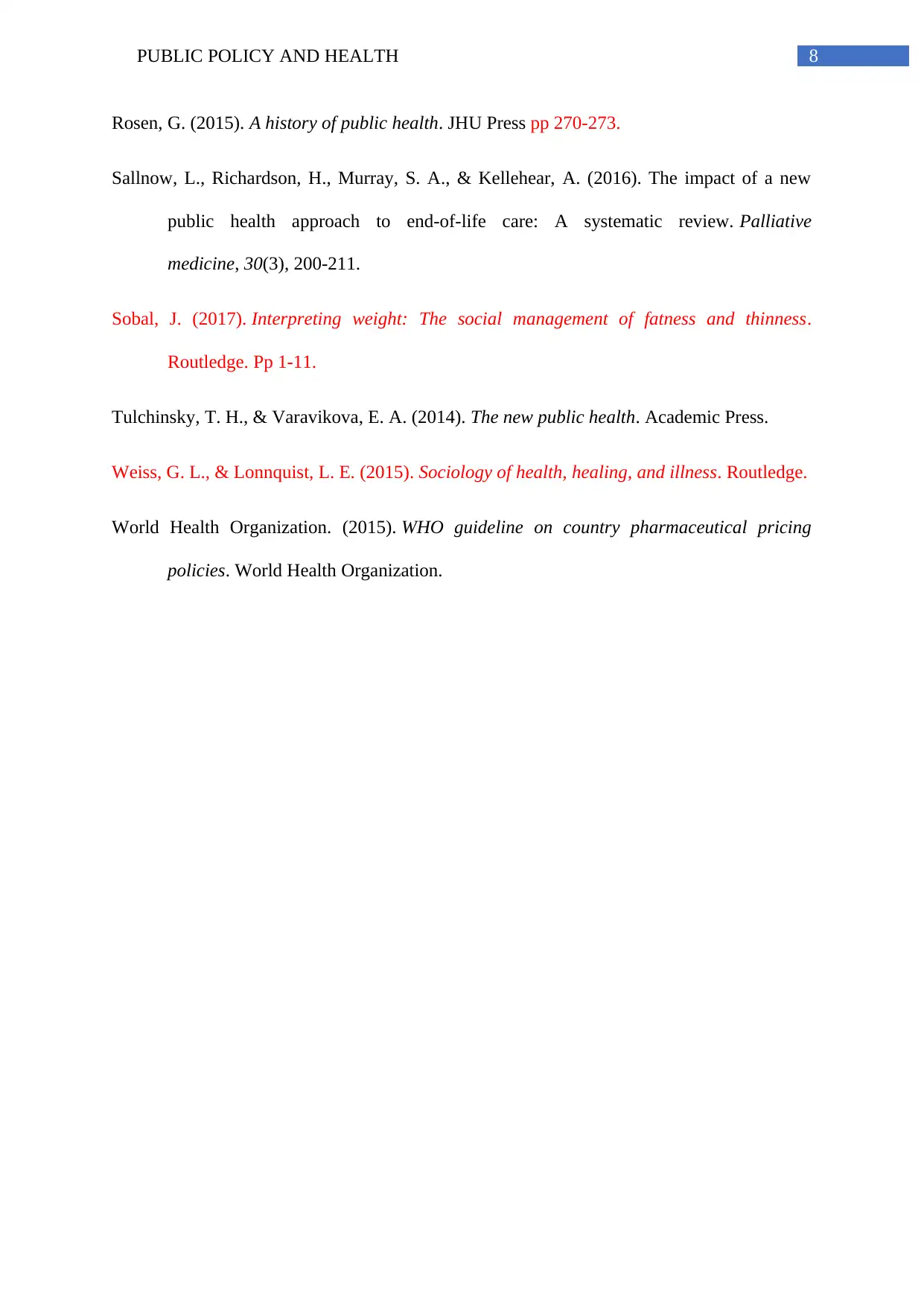
8PUBLIC POLICY AND HEALTH
Rosen, G. (2015). A history of public health. JHU Press pp 270-273.
Sallnow, L., Richardson, H., Murray, S. A., & Kellehear, A. (2016). The impact of a new
public health approach to end-of-life care: A systematic review. Palliative
medicine, 30(3), 200-211.
Sobal, J. (2017). Interpreting weight: The social management of fatness and thinness.
Routledge. Pp 1-11.
Tulchinsky, T. H., & Varavikova, E. A. (2014). The new public health. Academic Press.
Weiss, G. L., & Lonnquist, L. E. (2015). Sociology of health, healing, and illness. Routledge.
World Health Organization. (2015). WHO guideline on country pharmaceutical pricing
policies. World Health Organization.
Rosen, G. (2015). A history of public health. JHU Press pp 270-273.
Sallnow, L., Richardson, H., Murray, S. A., & Kellehear, A. (2016). The impact of a new
public health approach to end-of-life care: A systematic review. Palliative
medicine, 30(3), 200-211.
Sobal, J. (2017). Interpreting weight: The social management of fatness and thinness.
Routledge. Pp 1-11.
Tulchinsky, T. H., & Varavikova, E. A. (2014). The new public health. Academic Press.
Weiss, G. L., & Lonnquist, L. E. (2015). Sociology of health, healing, and illness. Routledge.
World Health Organization. (2015). WHO guideline on country pharmaceutical pricing
policies. World Health Organization.
⊘ This is a preview!⊘
Do you want full access?
Subscribe today to unlock all pages.

Trusted by 1+ million students worldwide
1 out of 9
Related Documents
Your All-in-One AI-Powered Toolkit for Academic Success.
+13062052269
info@desklib.com
Available 24*7 on WhatsApp / Email
![[object Object]](/_next/static/media/star-bottom.7253800d.svg)
Unlock your academic potential
Copyright © 2020–2025 A2Z Services. All Rights Reserved. Developed and managed by ZUCOL.





